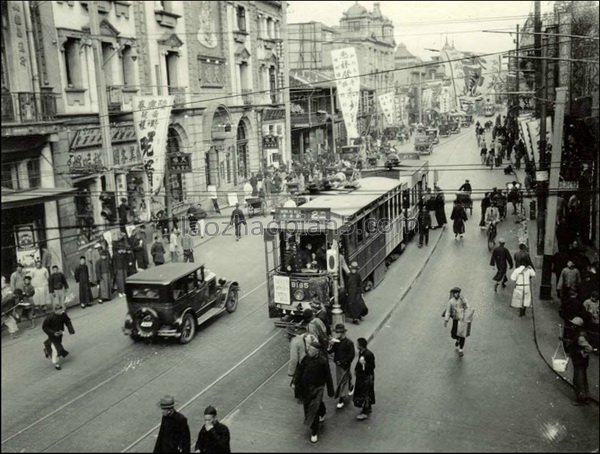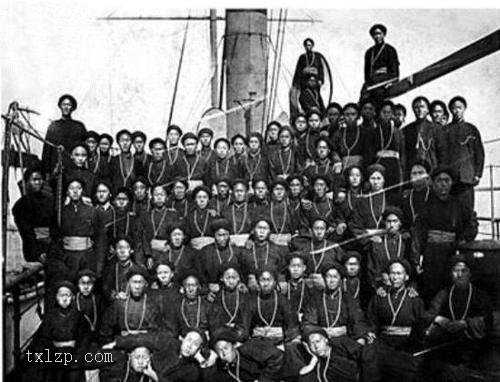Period:Unknown Production date:12thC
Materials:bronze, gold,
Technique:gilded
Subjects:bodhisattva
Dimensions:Height: 49.50 centimetres (Mounted on perspex stand) Height: 44.20 centimetres Weight: 3.27 kilograms Width: 11.20 centimetres (Mounted on perspex stand) Width: 11.20 centimetres Depth: 10.20 centimetres (Mounted on perspex stand) Depth: 6.50 centimetres
Description:
Standing figure of the bodhisattva Avalokiteśvara (Guanyin). This standing figure is designed to be looked at frontally, since it is entirely undecorated on the back. The large head is topped by a tall hairdress in which there sits a figure of Amithaba on a lotus throne. The hair fastened with a tiara clasp. Heavy, snail-like earrings are lying on the shoulders next to the jewelled necklace. The upper arms yield pearled clasps and only the right wrist has pearled bracelet. The right hand shows the vitarka mudra, which is a gesture referring to Buddhist teaching, and the left hand shows the varada mudra, signifying welcome and compassion. Much of the upper body is bare but with a waistbelt with ring bosses. The plain and straight garment is fastened with a round brooch atop a knot. The overproportionate feet sits on pegs that would have been joint to a stand that is now lost. The hole in the back would have been covered. Relics were probably stored inside. The gilding, probably mercury gilding, not much of which is left would have covered the entire figure.
IMG
![图片[1]-figure BM-1950-0215.1-China Archive](https://chinaarchive.net/Unknown/Bronzes/mid_00157544_001.jpg)
![图片[2]-figure BM-1950-0215.1-China Archive](https://chinaarchive.net/Unknown/Bronzes/mid_01095398_001.jpg)
Comments:These standing figures of Guanyin were made in the Dali Kingdom in present-day Yunnan. The have been identified and dated to the 12th century due to their depiction in the 12th century ‘Long Roll of Buddhist Images’ from the Dali Kingdom, now in the National Palace Museum, Taipei. This is confirmed by a similar figure in the San Diego Museum of Art, which is dated by inscription to 1147 to 1172. The ‘Long Roll’ identifies this Guanyin as Zhenshen (true body; dharnakaya) Guanyin. It is also known as Acuoye (Ajaya) Guanyin. ‘Luck of Yunnan’ was the nickname given to these figures by Helen Chapin. Buddhism became the official religion of the Nanzhao Kingdom (653-937), which was remaned Dali Kingdom later on, and Guanyin became the guardian of this kingdom. The origins of the particular iconography of this figure is unclear.Many of these figures are in western collections, such as the Asian Art Museum in San Francisco, Art Instiute of Chicago, Freer Gallery of Art, Washington, DC, Metropolitan Museum of Art, New York, Sumitomo Collection in Kyoto, Musee Guimet, Paris, as well as museums in Yunnan. Similar figures are also known carved in stone in Buddist cave temples in Yunnan. For further information, see Lutz 1991. Zwalf 1985This type of Avalokiteśvara image was made for the Dali court, in what is now Yunnan province, south-west China. Based upon Pallava and Śrīvijaya styles, such images appear to have been cast as talismans for the royal family. A painted version is included in a handscroll executed for the Hou (Later) Li court in the 1170s; there the image entitled ‘zhenshen’ Guanshiyin (True body Guanshiyin) is surrounded by a moonlike halo, and floats on a lotus over waves. The painting and bronzes are unlike any Buddhist figures of the contemporary Song and Jin dynasties, although the halo, and the waves below, recall more familiar depictions of the ‘shuiyue’ (Water Moon) Guanyin.
Materials:bronze, gold,
Technique:gilded
Subjects:bodhisattva
Dimensions:Height: 49.50 centimetres (Mounted on perspex stand) Height: 44.20 centimetres Weight: 3.27 kilograms Width: 11.20 centimetres (Mounted on perspex stand) Width: 11.20 centimetres Depth: 10.20 centimetres (Mounted on perspex stand) Depth: 6.50 centimetres
Description:
Standing figure of the bodhisattva Avalokiteśvara (Guanyin). This standing figure is designed to be looked at frontally, since it is entirely undecorated on the back. The large head is topped by a tall hairdress in which there sits a figure of Amithaba on a lotus throne. The hair fastened with a tiara clasp. Heavy, snail-like earrings are lying on the shoulders next to the jewelled necklace. The upper arms yield pearled clasps and only the right wrist has pearled bracelet. The right hand shows the vitarka mudra, which is a gesture referring to Buddhist teaching, and the left hand shows the varada mudra, signifying welcome and compassion. Much of the upper body is bare but with a waistbelt with ring bosses. The plain and straight garment is fastened with a round brooch atop a knot. The overproportionate feet sits on pegs that would have been joint to a stand that is now lost. The hole in the back would have been covered. Relics were probably stored inside. The gilding, probably mercury gilding, not much of which is left would have covered the entire figure.
IMG
![图片[1]-figure BM-1950-0215.1-China Archive](https://chinaarchive.net/Unknown/Bronzes/mid_00157544_001.jpg)
![图片[2]-figure BM-1950-0215.1-China Archive](https://chinaarchive.net/Unknown/Bronzes/mid_01095398_001.jpg)
Comments:These standing figures of Guanyin were made in the Dali Kingdom in present-day Yunnan. The have been identified and dated to the 12th century due to their depiction in the 12th century ‘Long Roll of Buddhist Images’ from the Dali Kingdom, now in the National Palace Museum, Taipei. This is confirmed by a similar figure in the San Diego Museum of Art, which is dated by inscription to 1147 to 1172. The ‘Long Roll’ identifies this Guanyin as Zhenshen (true body; dharnakaya) Guanyin. It is also known as Acuoye (Ajaya) Guanyin. ‘Luck of Yunnan’ was the nickname given to these figures by Helen Chapin. Buddhism became the official religion of the Nanzhao Kingdom (653-937), which was remaned Dali Kingdom later on, and Guanyin became the guardian of this kingdom. The origins of the particular iconography of this figure is unclear.Many of these figures are in western collections, such as the Asian Art Museum in San Francisco, Art Instiute of Chicago, Freer Gallery of Art, Washington, DC, Metropolitan Museum of Art, New York, Sumitomo Collection in Kyoto, Musee Guimet, Paris, as well as museums in Yunnan. Similar figures are also known carved in stone in Buddist cave temples in Yunnan. For further information, see Lutz 1991. Zwalf 1985This type of Avalokiteśvara image was made for the Dali court, in what is now Yunnan province, south-west China. Based upon Pallava and Śrīvijaya styles, such images appear to have been cast as talismans for the royal family. A painted version is included in a handscroll executed for the Hou (Later) Li court in the 1170s; there the image entitled ‘zhenshen’ Guanshiyin (True body Guanshiyin) is surrounded by a moonlike halo, and floats on a lotus over waves. The painting and bronzes are unlike any Buddhist figures of the contemporary Song and Jin dynasties, although the halo, and the waves below, recall more familiar depictions of the ‘shuiyue’ (Water Moon) Guanyin.
© Copyright
The copyright of the article belongs to the author, please keep the original link for reprinting.
THE END

![[Qing Dynasty] British female painter—Elizabeth Keith, using woodblock prints to record China from the late Qing Dynasty to the early Republic of China—1915-China Archive](https://chinaarchive.net/wp-content/uploads/2022/11/image-191x300.png)



